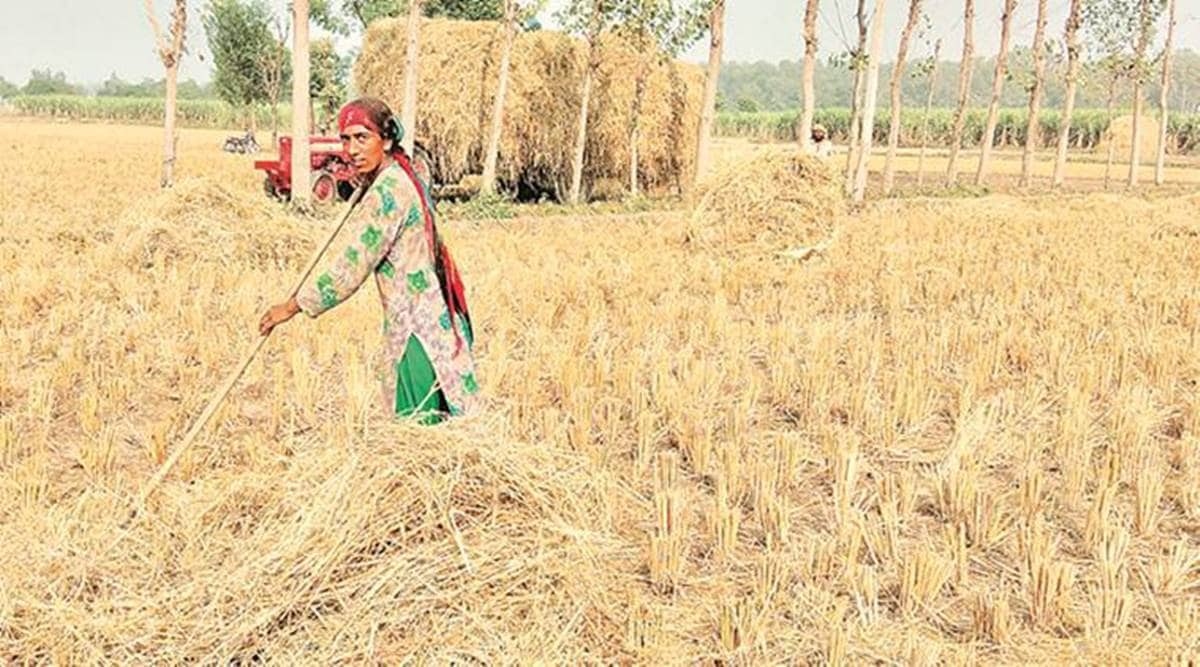 Experts assert that with available resources, the fires should not go beyond 20% to 25% of the total paddy area. (Representational)
Experts assert that with available resources, the fires should not go beyond 20% to 25% of the total paddy area. (Representational)Although clouds of smoke from stubble burning are rising in the sky, here’s a silver lining: this year Punjab will produce 15% less stubble than the previous years.
For the past several years, Punjab has been witnessing a production of around 20 million tonnes (200 lakh tonnes) of paddy stubble. However, it came down to around 17 million tonnes (170 lakh tonnes) this year.
Experts assert that with available resources, the fires should not go beyond 20% to 25% of the total paddy area.
As per information available, the state has grown paddy on around 20.76 lakh hectares this year and basmati on 6.60 lakh hectares. Experts say that 6.5 tonnes of paddy stubble and 5 tonnes of basmati stubble is produced per hectare, respectively, in Punjab.
Going by these calculations, Punjab’s stubble production from paddy would be 13.49 million tonnes this year and from basmati it will come around 3.3 million tonnes. The total stubble production in the state is around 16.79 million tonnes against the previous years’ around 20 million tonnes.
“In 2018, Punjab had seen an all-time area under paddy crop with 25.92 lakh hectares (64 lakh acres) and 5.11 lakh hectares (12.6 lakh acres) under basmati. The state had produced 19.55 million tonnes stubble then,” says a senior officer in the Punjab agriculture department. He adds that this year a large acreage was under direct seeding of rice (DSR) too which does not need puddling of the field, and in such soil the mixing of stubble is very easy against the puddled fields.
Since 2018, the overall reduction under rice area has been 3.67 lakh hectares (9.06 lakh acres) in Punjab but if we see paddy acreage, which is a highly water-consuming crop, then the area under paddy alone has gone down by 5 lakh hectares (12.25 lakh hectares) from 25.92 lakh hectares in 2018 to 21.76 lakh hectares in 2020.
“It is a major development that we could decrease area under paddy, which means less production of stubble. Now out of this 17 million tonnes of stubble production, nearly 3 million tonnes is used in several industries and for cattle feed — basmati stubble is used for cattle fodder in the state. The remaining around 14 million tonnes is to be managed through in-Situ,” says engineer Manmohan Kalia, Joint Director (Acting), farm machinery wing, Punjab agriculture department and nodal officer (stubble management), adding that last year too around 7 million tonnes was managed through in-situ only.
In-situ is a method of incorporating crop residue in the soil only through stubble management machinery by avoiding fire. It improves the soil health because stubble carries several nutrients too.
Punjab has around 23,000 happy seeders and super seeder machines and nearly 6,500 combines harvesters having an attachment of Super SMS. Apart from this, there are around 40,000 other machines for managing stubble, including balers, mulcher and cutter. The government has already formed around 19,000 custom-hiring centres — 8,000 till last year and 11,000 new centres this year — so as to provide machines to farmers on rent but most of the newly formed centres have just a single machine for stubble management.
Experts maintain that a super SMS can harvest around 17-18 acres per day and harvesting period goes for 45 to 50 days from the third week of September to early November. While a happy seeder and a super Seeder can sow on 7-8 acres to 5-6 acres wheat in a day, the sowing period also lasts around 30 days in Punjab from October last week to November last week.
By these calculations, 6,500 combine harvesters can harvest around 58.50 lakh acres (23.68 hectares) rice area in the state out of 27.36 lakh hectares, which is around 87% of the total paddy area while 23,000 Happy Seeders and Super Seeder can sow nearly 50.50 lakh acres (20.44 lakh hectares) which comes to 75% of the total paddy area, according to a senior scientist at Punjab Agriculture University (PAU), Ludhaina.
In such a situation, the stubble fire should not go beyond 20% to 25% paddy area, says the senior scientist.
Last year, more than 60% paddy area was set on fire as per the satellite images of the Punjab Remote Sensing Centre, Ludhiana.
“To bring down the stubble fire to just 20% to 25% is not possible right now because in several parts of the state, despite the availability of machines, farmers are not hiring these because they find running of these machines a costly affair, though the government has fixed nominal charges for these. All these machines are tractor-mounted and tractor charges are quite high per acre,” said a senior officer in the agriculture department.
📣 The Indian Express is now on Telegram. Click here to join our channel (@indianexpress) and stay updated with the latest headlines
For all the latest Chandigarh News, download Indian Express App.